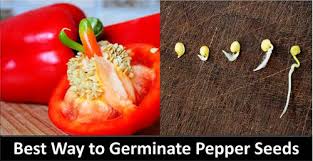Pepper plants, from sweet bell peppers to spicy chili varieties, add vibrant flavors to any garden or kitchen. Growing peppers from seeds can be both a rewarding and cost-effective venture, but successful germination is key. Whether you’ve harvested seeds from your own peppers or purchased them from a store, starting your pepper seeds indoors ensures you have control over the growing conditions, leading to better success rates. Below are the best practices for germinating pepper seeds, including those you’ve saved or bought.
1. Harvesting and Preparing Pepper Seeds
If you’re using seeds from peppers you’ve grown or purchased, the process begins with careful seed harvesting. Here’s how:
- Choose a ripe pepper: Opt for a fully mature pepper to ensure the seeds are viable.
- Cut the pepper open: Slice it carefully to avoid damaging the seeds.
- Remove the seeds: Gently scoop the seeds out with a spoon or your fingers.
- Clean the seeds: Rinse them thoroughly to remove any remaining pepper flesh, and spread them on a paper towel to dry for a day or two.
2. Starting Seeds Indoors
Peppers are sensitive to temperature changes, so starting seeds indoors gives you a controlled environment. This method protects your seeds from sudden weather shifts and ensures stable growing conditions, essential for successful germination.
3. Choosing the Right Germination Method
There are a few effective methods to start pepper seeds indoors:
- Traditional Seed Starting Mix: Use a lightweight, well-draining, and sterile seed mix. Plant seeds at a depth of about 1/4 inch (0.6 cm). Sow one or two seeds per cell or pot to improve your chances of success.
- Moist Paper Towel Method: Place the seeds on a moist paper towel, fold it over, and seal it in a plastic bag. Keep the bag in a warm area (75-85°F or 24-29°C) to encourage germination. This method mimics a mini-greenhouse effect and is ideal for monitoring seed progress.
4. Maintaining Optimal Conditions
Certain environmental factors are crucial for germinating pepper seeds:
- Temperature and Humidity: Peppers thrive in warmth. A seed heating mat can help maintain the ideal temperature. Use a plastic dome or clear plastic wrap to retain moisture around your seeds.
- Light: Once your seeds sprout, they need plenty of light. Place the seedlings under fluorescent or LED grow lights for 12-16 hours daily, keeping the lights 2-4 inches above them to encourage strong, healthy growth.

5. Transplanting Your Seedlings
Once your pepper seedlings have at least two sets of true leaves, they’re ready for transplanting. Gently lift the seedlings by their leaves—avoid touching the stems—and move them into larger pots or directly into the garden if the weather permits.
6. Hardening Off Before Outdoor Planting
Before transferring your seedlings outdoors, they must be acclimated to outdoor conditions. Gradually expose them to sunlight, starting with a few hours and increasing the exposure each day. This process, known as hardening off, helps prevent transplant shock and ensures a smoother transition.
Conclusion
Germinating pepper seeds successfully is the first step toward growing healthy, productive plants. Whether you’re using store-bought seeds or ones harvested from your own peppers, following these simple steps ensures that you’ll have thriving plants ready for harvest. With careful attention to temperature, light, and humidity, you can enjoy the fruits of your labor in the form of delicious bell peppers or spicy chilies. By taking the time to nurture your pepper seeds, you’ll be rewarded with a bountiful crop that adds both flavor and vibrancy to your garden and meals.
